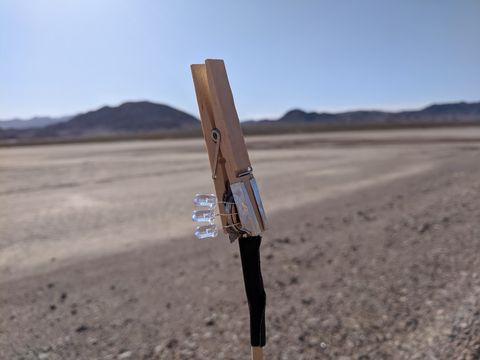How to Make a Scale Model of the Universe
You’ve probably seen scale models before—toy trucks, the battlefield diorama at the Gettysburg History Center, Elijah Wood—but you’ve probably never seen them at the scale that filmmakers Wylie Overstreet and Alex Gorosh work in. Their first project, To Scale: The Solar System, spanned seven miles in a dry lakebed in the Nevada desert in 2015. It accurately reproduced the sun and its surrounding planets if Earth were the size of a marble. The 140 million miles between Earth and Mars became 302 feet between a small blue marble and a red one about two-thirds the size. The 2.8 billion miles between the sun and Neptune became 3.5 miles. Then they strapped lights to their vehicles, drove the scaled orbits, and captured the whole thing on time-lapse video. For their latest project, To Scale: Time, Overstreet and Gorosh decided to build a scale model of time. All 13.8 billion years of it.
The challenge of visualizing things like light-years and eons, which our brains just weren’t meant to comprehend, is that they weren’t really meant to exist on Earth. Overstreet and Gorosh wanted the length of a human life to be represented as more than just a microscopic speck on their timeline. In order for a lifetime to be the thickness of just one sheet of paper, however, the timeline would have to be eight miles long—farther than the drone they were filming with could fly on one charge. They cut that distance in half by downsizing a lifespan to the width of a single hair. And so Overstreet found himself walking his trusty click wheel through four miles of Southern California desert. Every ten meters he stopped and planted a stake: a tick mark of 20 million years.
To make the timeline visible from above, they planned to top those stakes with LED lights. That caused a new problem: They had only a brief window of time around sunset to film, when there was enough light to show off the landscape but not enough to overpower the LEDs. Since the batteries wouldn’t last long enough to turn everything on before filming, Overstreet and Gorosh set up a slow-moving assembly line. Four people in an SUV made and lit lights as the truck inched forward, while runners went back and forth affixing them to the stakes.
After waiting as long as he could, Gorosh launched the drone. From start to finish, the Big Bang to today, took twelve minutes to film—not a second longer than the light team needed. In the final shot, where the drone shoots straight up in the air to capture all 13.8 billion years of our universe’s history in one frame, you’ll see one thing that isn’t according to scale: an SUV surrounded by tiny, cheering dots.
https://www.popularmechanics.com/space/deep-space/a22757912/how-to-make-a-scale-model-of-the-universe/
Tidak ada komentar